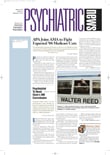The Viewpoints column by Dr. James Sabin in the April 4 issue argued for the virtues of restrictive psychiatric formularies. The column is timely, given the chaotic events that have been occurring in various states around attempts to restrict access to psychiatric medications.
Dr. Sabin’s viewpoint is in opposition to that of APA as well as a collaborative effort by APA, the National Alliance for the Mentally Ill (NAMI), and the National Mental Health Association (NMHA) whose purpose is to advocate for open access to psychiatric medications.
While Dr. Sabin’s opinion may be commonly shared among administrators, payers, and some clinicians struggling with draconian budget deficits, it is not consistent with that of the average mental health “advocate.”
Let’s look at whether the evidence supports the rationing of psychiatric medications, particularly the antidepressants and antipsychotics. These are the classes of psychiatric medications that have received the most attention from payers.
While there are individual comparative studies that might support the argument that some agents within these two classes are interchangeable, there are no definitive studies that lend clear scientific support to this notion. You can check my Web site at www.medaccessonline.com for extensive background information on the new-generation antipsychotics.
I have been an early bearer of the notion that when treatments are equally effective, go with the less-expensive option. However, when it comes to antidepressants and antipsychotics, this is not the case. We can certainly debate the question, but no expert can say with certainty that the antipsychotics or antidepressants are “equally” substitutable within their respective classes.
In addition to the absence of definitive comparative data, there are other sources of evidence that should caution those who want to restrict psychiatric formularies. A 1994 study by Soumerai, et al., demonstrated to New Hampshire Medicaid payers that restrictions placed on use of conventional antipsychotics may have reduced the amount of spending on these medications, but led to a 17-fold increase in consequent costs of clinical services.
More recent studies of the general impact of formulary restrictions consistently demonstrate resulting inefficiencies. Studies such as these led the NMHA to publish Penny Wise and Pound Foolish (www.nmha.org/state/pennywise.pdf) and NAMI to disseminate the findings from its NAMI Policy Research Institute’s Access to Medication task force (www.nami.org/update/000709.html).
Putting the controlled studies to the side, any experienced clinician, family member, or patient/consumer knows that the chemical structures of these agents vary tremendously, and with that, we see individuality of response—from both efficacy and safety perspectives.
I fear that the basis to argue for formulary restrictions derives more from concerns about drug acquisition costs than from any rational, clinically scientific concern. I am afraid that politics is speaking louder than science.
If we do choose to ration medications, what then are the “best practices”?
There are many strategies—even “realistic” strategies—that can assure cost-effectiveness in the treatment plan. First, the biggest gap to success in this area is the absence of integrated information systems to connect formulary design with clinical outcomes. Rarely is any system of care able (or willing) to measure the impact of formulary decisions on long-term (greater than six months) consequences.
Second, drug utilization review (DUR) should become a leading mechanism to deter “careless” or “unnecessary” prescribing. Regulatory agencies have gotten us to “go through the motions” of DURs, but it is time that we start taking the process seriously.
Third, prescriber education separate from, but also coordinated with, solid pharmaceutical company support offers valid methods to promote efficiency. Incidentally, the Food and Drug Administration ought to follow colleagues in other countries who require pharmacoeconomic data for approval of new medications.
Finally, we are learning that there are legitimate ways to leave the decision making to the prescriber while aligning his/her financial incentives toward efficiency; that is, when our prescribing behavior is connected to our service rating.
If we are going to restrict treatment options, let’s be sure that the policy follows the science and that a publicly transparent decision-making process is employed. Let’s be sure that we measure the impact of whatever we do on the lives of our patients and their families and hold ourselves accountable to them.
If you don’t believe me, APA, NAMI, or NMHA, read the recent subcommittee report on evidence-based practices on mental health policy and psychotropic drugs in the report of the President’s New Freedom Commission on Mental Health posted at www.mentalhealthcommission.gov. ▪

